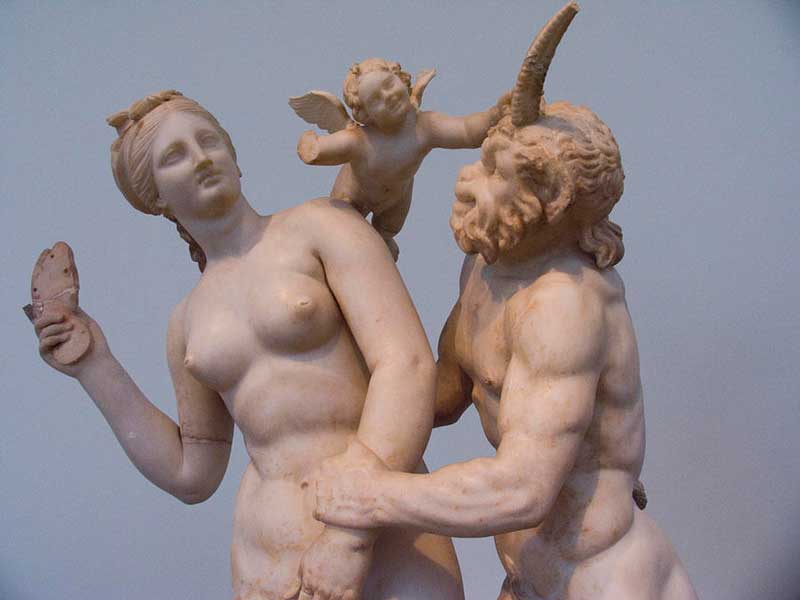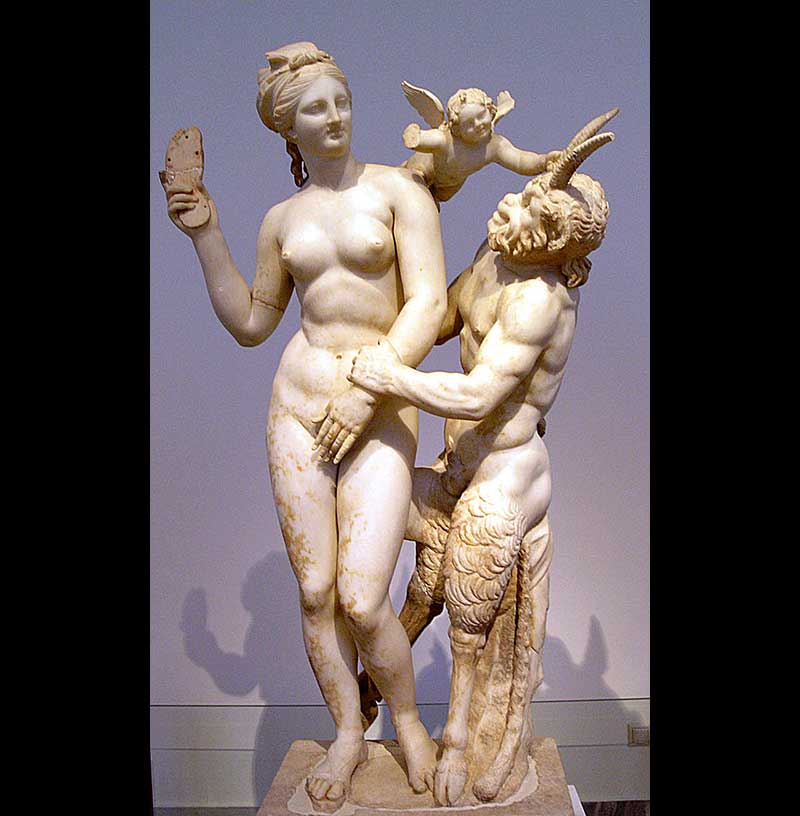
A sculpture of Aphrodite, Pan and Eros, exhibited in the National Archaeological Museum of Athens, in Greece, is estimated to be carved at about 100 BC, by an unknown sculptor. It was made of Parian marble, one of the world's finest semi translucent pure-white marble, famous since the ancient times. The beautiful piece of art was found in 1904, on the island of Delos, in a room of the Hall of the Guild of the Poseidoniasts of Beirut, who were the worshippers of the god Poseidon. According to the inscription on the lower base of the group, it was dedicated by Dionysos, grandson of Theodoros and son of Zenon, from Beirut, to the ancestral gods for his own benefit, as well as that of his children.
In Greek Mythology, Aphrodite (Venus for the Romans) is the goddess of love, beauty, pleasure, passion and procreation. Victim of her own success and beauty, Aphrodite has never lost her sense of earthy pleasure. Eros or Cupid, son of Aphrodite and the god of love, is sometimes innocent with rosy cheeks and a beautiful smile, other times he is mischievous, tormenting people with his arrows to fill their hearts with uncontrollable desire.

Pan (Roman Faunus), the comic figure in the sculpture, is associated with nature and animals. The bottom half of his body was like a goat, complete with cloven hooves and a tail, while the upper half of his body was like a man. Apart from that, he was born with two horns coming out of his forehead, crooked nose and pointed ears. Following his natural instinct for raw sexual fulfillment, Pan had the habit of chasing the scared nymphs intending sex and made them run with pounding hearts. He was particularly obsessed with the seductive beauty of Aphrodite.

In the sculpture Aphrodite, the stark naked goddess of beauty and love is rendered frontally with her hair well-combed and tied up by means of a scarf bound in a bow above her parting. She is brandishing a sandal in her slightly raised right hand, but her muscles are relaxed. Her face has a veiled smile and the angle of her head is such that she is not directly looking at Pan. She holds her left hand in front of her pubic triangle, which she is trying to cover or protect with her left palm from the indiscreet intentions of the philanderer Pan, but her palm is relaxed and at some distance from her flesh.
The manner in which she bends her left leg lends a gracefulness to her stance. Her ankle is relaxed and playful, restrained, but not aggressive. It seems from her appearance that, she is not at all tensed or worried about the presence or the intention or the strength of Pan, she is rather relaxed and neglecting the poor, persisting and comical Pan, with her indifferent attitude. It seems that she is actually enjoying the situation.


The goat-footed, ugly and horned Pan presents a miserable and pathetic figure in the sculpture. He has seized her left wrist with his sinewy left hand, as if trying to take her palm off from her private area.
But, there is no aggression in his gesture and it seems that he is rather praying for her favour and trying to pursue her.

Eros, the little winged son of Aphrodite, is presented in the middle of the two protagonists. Apparently he is trying to separate the two and protect his mother from the grasp of Pan the devil. However, his action does not look like a serious attempt, rather it looks like an act of playing. He tries to push away Pan by grasping his right horn, which is more touching than pushing, while smiling all the time.